July 15, 2004
SGAA Boston 2004 - Day by Day
Note that this is my own version of the conference. I did not see everything and so cannot comment on everything. Such is conference life.
DAY ONE - Saturday, June 26, 2004
My day started with tours of Church of the Covenant and Arlington Street Church, both in Boston and walking distance from the Park Plaza, where the conference was located. Church of the Covenant has many Tiffany Studio windows, and a nice St. Francis window by Reynolds, Francis and Rohnstock. Arlington has a full program of Tiffany windows, featuring some of the very best designs by Frederick Wilson, one of Tiffany's top designers.
This is a detail of the St. Francis window, Church of the Covenant -
I especially like the birds in the lower right looking up to St. Francis.
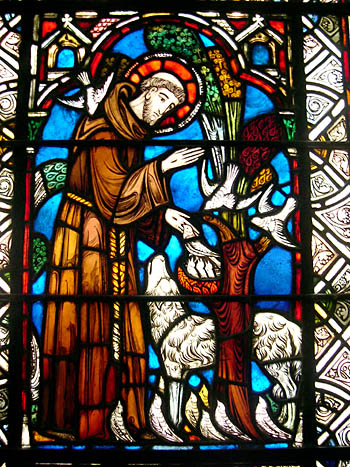
Here is one of my favorites from Arlington St. Church, designed by Wilson - "Madonna of the Flowers"
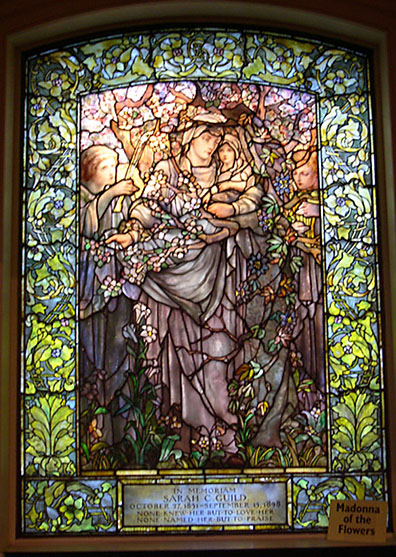
The highlight of the day was undoubtedly the talk by Debora Coombs in the afternoon. Alas, her website doesn't give the full picture. I was very impressed by the new windows she is doing at Marble Collegiate Church in NYC. What a relief to see someone emphasizing drawing as a skill needed for a stained glass artist/designer/painter.
This day also featured the first general assembly and in the evening there was the opening reception and buffet, always a good chance to reconnect with those friends and colleagues you haven't seen in a long time and meet those you have heard of but never met. The highlight here was to see and meet Albinas Elskus, who got a big round of applause when he was first introduced.
DAY TWO - Sunday, June 27, 2004
Dick Millard gave a talk on doing transparent sketches. The highlight was seeing the sketches themselves - I'd heard about them for years.
Karen Long gave a talk on lead safety. A tough, straight shooting talk about how studios need to have written lead safety compliance plans and work toward enforcing those plans. And they need to do this NOW. Some related links are the OSHA website, the OSHA lead information page, the EPA website, the OSHA small business assistance program webpage.
This is important stuff. There are still too many studios who swing wildly between denial and paranoia when it comes to lead safety. The key is in educating yourself and using common sense.
Later in the morning there was a tour of the Christian Science Church and the Mapparium. Some highlights - First, from the oldest part of the building, there were some fairly primitive opalescent windows. I like this detail from a peacable kingdom window, a subject I've long thought about doing myself.
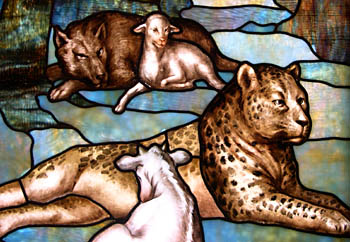
Then, in the newer part of the building, there are some nicely painted decorative windows. In general, I liked these better than the opalescent. Very solid design and well painted.
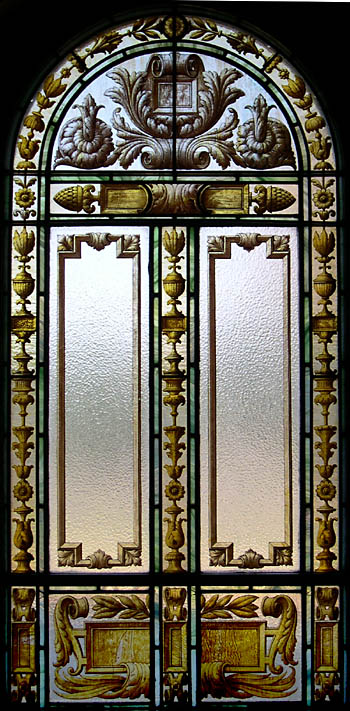
and a detail
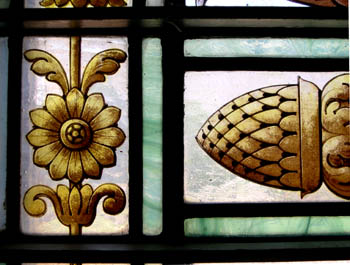
As for the Mapparium, it is stunning in some ways and pretty creepy in others. The Mapparium is a 30 foot diameter painted glass 3D representation of the earth. You walk inside it and see a light and sound show. For me, it's most interesting as a technical achievement. As an experience of a work of art, I find it pretty creepy. I may be out of step with the times regarding current exhibition practices - one could say that the Mapparium is ahead of it's time in that it presents a work of art like a theme park ride. Some might even view it as a 'conceptual installation piece'. I'm enough of a curmudgeon to say that's exactly what I don't like about it.
In the afternoon, there was a tour/talk with Julie Sloan on the windows of Trinity Church. When I lived in Boston I spent many hours in Trinity Church, so I have many fond memories here as well, and my own favorites. Many on the tour liked the Margaret Redmond windows more than the large imposing LaFarge windows.
My favorite remains the Baptistry Window, designed by Edward Burne-Jones.
Not a very good photo, but here it is.
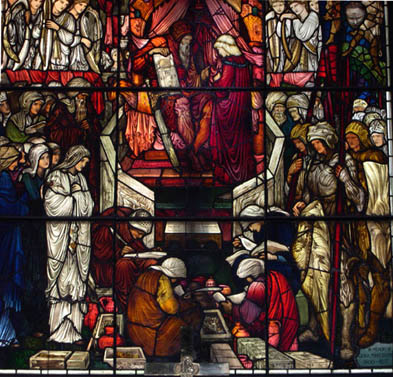
Many of the Burne-Jones windows have such little variety of character. This one is different. Alas, I could not get closer to photograph any details. This window is best in its details.
DAY THREE - Monday, June 28, 2004
In the early a.m. Barbara Kreueger spoke of her experience with doing a Statewide Survey of Stained Glass Windows for Michigan.
Then the one and only Virginia Raguin gave some historical background on American stained glass. I've known Virginia for over 20 years now and have heard her speak many times. There are few in Academia who can match her enthusiasm and energy.
There was a professional overview of current Stained Glass Conservation practices given by Art Femenella.
Jean Farnsworth gave a talk related to her book Stained Glass in Catholic Philadelphia. On this same website there is also an impressive Gallery of Stained Glass at St. Joseph's University. Lots of Munich style windows and quite a few curiosities.
Sylvia Nicolas showed some of her work, as did her son Diego Semprun Nicolas.
Alan Joslin gave a talk on the collaborative process of architect and artisan by way of talking of the creation of the Glavin Chapel at Babson College. Peter McGrain worked on this with Alan and the other artisans.
Finally, Lyn Hovey gave an overview of his studio work for the past 30 years. I worked for Lyn in the 80's so I saw quite a few familiar works and a few that I had not seen before.
That evening there was a reception at the Boston Public Library sponsored by the Connick Foundation. Much credit should be given to Marilyn Justice of the Connick Foundation to get the exhibit up and running on short notice.
Unfortunately, the website for the Connick foundation still does not have any gallery yet, or even links to any Connick sites. The least they could do is to include some links to websites that feature Connick windows, such as this one for the Alexander Browning Library in Texas... or this from All Saint's Parish Church in Brookline, Mass. This church contains Connick windows spanning from 1912 to 1986!
DAY FOUR - Monday, June 29, 2004
In the morning I visited the studio of Dan Maher. I've known Dan for over 20 years and worked with him and for him for many years. He showed me a nice commission for a Memorial Window he had just finished for Youville Hospital in Cambridge, Mass. A detail -
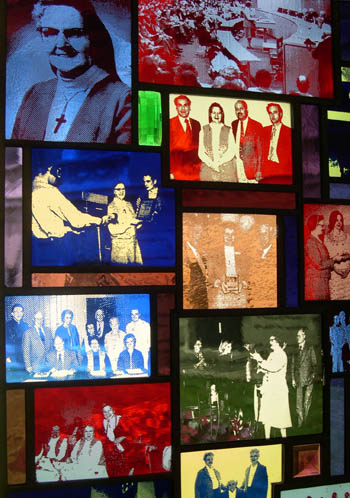
There is no paint on these windows. This is all done on flashed glass. Great stuff!
I went back to the conference in the afternoon to hear the talk by Dick Millard on "The Educational Challenge". For those who do not know him (and in the professional world of stained glass there are very few who do not know him) Dick Millard has been working professionally in stained glass for something like 50 years. He is, to put it mildly, outspoken in his opinions.
He gave some background on 'the education of the stained glass artist' in the past 50 years. It was most interesting to hear his description of going through the now defunct 'formal apprenticeship program' back inthe 50's, along with the likes of Albinas Elskus. He then gave a rather scathing assessment of efforts by the SGAA over the years to incorporate the idea of education into their activities (unfortunately, the failure of the "Stained Glass School' at Flagler College made for a low buzz throughout the entire conference).
He then went into his own vision for a stained glass education. The various components, a course of study, that would make for a well rounded stained glass artist. Most of it concentrating on the technical aspects, emphasizing integrity (no nepotism) and quality (choose the best, not the best connected). I would agree with Dick in that the biggest obstacle remains the attitudes of the studios themselves, in hanging on to outdated ideas about the fear of 'teaching your competitors' and letting out 'trade secrets' and the like. Fear and complacency remain the biggest enemies. I would disagree with Dick in that I believe it will have to happen through fine art departments in academic institutions or, at least, art schools. Workshops and single courses through studios will not be enough.
At the very least, I hope this opens up debate on how to train and educate people for doing stained glass. It is an important issue and not an easy one. But it is the key to the future success of stained glass. There is no formal program of study in stained glass at all in the USA. There are glass programs galore, due to the popularity of the studio glass movement, but stained glass has never really fit within the studio glass movement. Those glass programs may or may not have a few classes in stained glass, but no entire course of study that is specifically for stained glass.
I like Dick Millard. I don't always agree with his opinions or his manner of delivery, but I admire his candor. We need it. I also like his stained glass work and wish there were some of it to see on the web. I could find none. It's too bad because he remains an excellent designer and painter of stained glass. I wish more people saw his work.
I was sorry that I missed the presentation by Stephen Lambert of Lambert Glass. I liked the little CD/movie from Lambert's that was part of the conference package.
On the whole the conference had much to admire and much of the credit is due to Maria Serpentino of Serpentino Studios for being the organizational force behind it all.